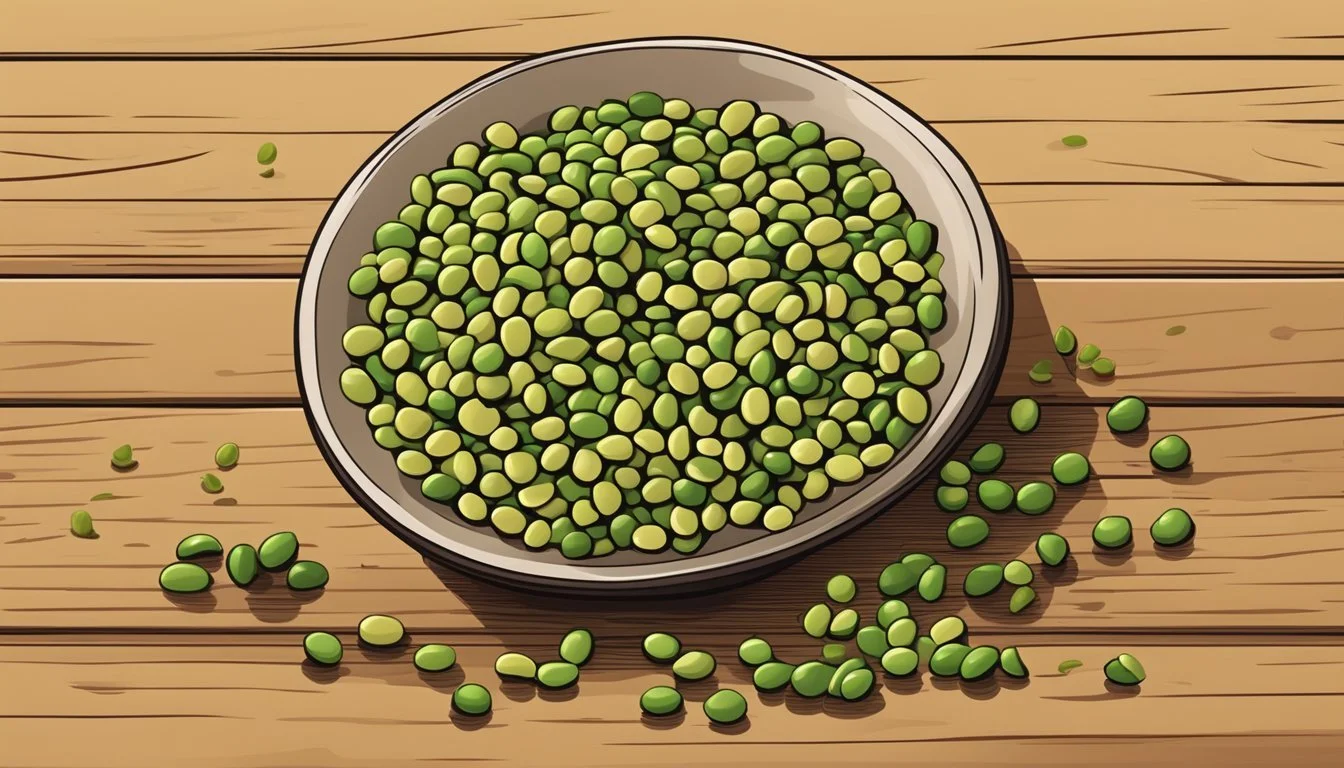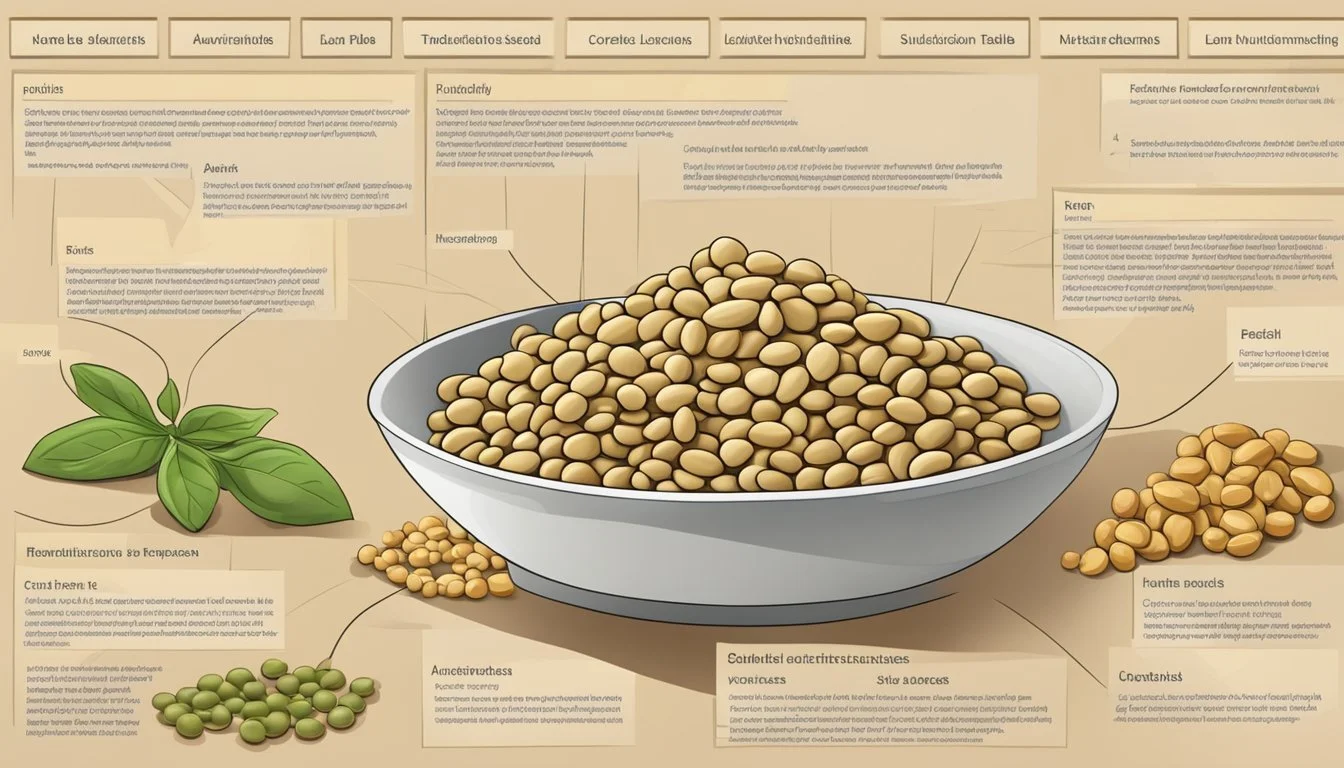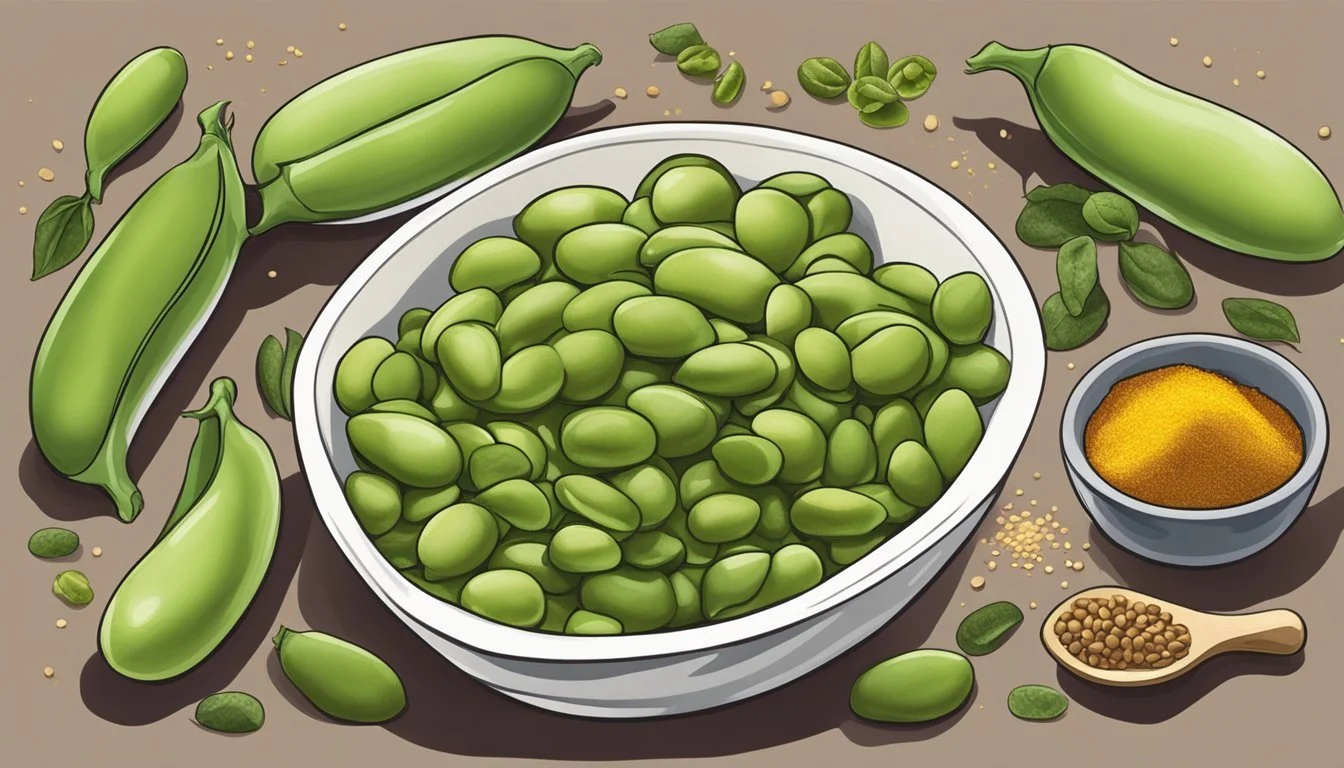Fava Beans Substitutes
Top Alternatives for Your Recipes
Sometimes your pantry might be missing an ingredient that you need, like fava beans, but don't worry. Fava beans are a versatile legume used in many cooking styles. There are several excellent substitutes available.
For soups and stews, cannellini beans are a good option because they have a similar soft texture. Chickpeas can also be used in dishes where falafel is needed. Green peas can mimic both the texture and taste of fava beans and are highly accessible year-round.
From fresh or canned cannellini beans to green peas and chickpeas, these alternatives offer convenient and practical solutions, making it easy to continue enjoying your favorite recipes without compromising on taste or quality.
Understanding Fava Beans
Fava beans are not only versatile in the kitchen but also offer notable nutritional benefits.
Nutritional Profile of Fava Beans
Fava beans are nutrient-dense, providing an excellent source of protein and fiber, making them a great choice for those seeking to boost their daily nutritional intake. They are rich in minerals like iron and potassium. Additionally, fava beans are low in calories and fat, which makes them a healthy addition to various meal plans. They support the immune system due to their high levels of vitamins and antioxidants.
Culinary Uses of Fava Beans
In the kitchen, fava beans are prized for their versatility. They can be used in soups, stews, salads, and even as a standalone dish. Their creamy texture and neutral taste allow them to blend seamlessly into various recipes, providing both flavor and nutritional benefits. Fava beans can be utilized fresh, dried, or canned, catering to different cooking needs and preferences.
Fava Beans in Different Cuisines
Fava beans hold a significant place in several culinary traditions. They are a staple in Italian cuisine, often found in dishes like pasta and fava bean puree. In Middle Eastern cuisine, they are used in falafel and ful medames. North African cuisine sees them in hearty stews and tagines. The bean's adaptability and unique flavor make it a cherished ingredient across these diverse culinary landscapes.
Primary Fava Bean Substitutes
When searching for an alternative to fava beans, you'll find several options with similar textures and flavors. Each substitute brings unique qualities to dishes, often enhancing both taste and nutritional value.
Lima Beans as a Substitute
Lima beans, also known as butter beans, offer a creamy texture and neutral flavor similar to fava beans. They are small, round, and green, making them quite visually similar. Although they cannot be eaten raw, they work well in most recipes calling for fresh fava beans, especially in stews, soups, and salads. Lima beans are accessible and can easily be found in both canned and dried forms in supermarket aisles.
Chickpeas for Texture and Flavor
Chickpeas, also known as garbanzo beans, are another excellent substitute. They bring a slightly nutty flavor and firm texture. Rich in protein, fiber, and essential minerals, chickpeas provide a nutritional boost. Chickpeas work well in soups, stews, and salads. They also shine in Middle Eastern dishes like hummus or falafel, easily replacing fava beans in these recipes. Both canned and dried varieties are readily available.
Using Kidney Beans
Kidney beans provide a hearty and dense alternative. Their nutty flavor and firm texture can mimic those of fava beans in many dishes. Best suited for soups, stews, and side dishes, they hold up well to long cooking times. Available in red and white varieties, red kidney beans are a bit firmer and sweeter, while white kidney beans, also known as cannellini beans, have a creamier texture. Both types deliver versatility and flavor to meals.
Cannellini Beans
Cannellini beans are a great fava bean substitute due to their mild flavor and silky texture. They are particularly useful in Italian cuisine, ideal for dishes such as pasta e fagioli or minestrone soup. These beans are often sold canned, making them a convenient option for quick recipes. Their creamy texture and slightly nutty flavor closely resemble those of fava beans, making cannellini an excellent choice.
Additional Substitutes and Their Unique Qualities
Several alternatives to fava beans provide unique flavors and textures that can enhance various dishes. These substitutes include fresh options like edamame and snow peas, creamy butter beans, hearty lentils, and versatile green peas.
Edamame and Snow Peas for Freshness
Edamame offers a fresh, slightly sweet taste. These young soybeans are rich in protein and fiber, making them a healthy substitute. They maintain a firm texture when cooked and can be used in salads, stir-fries, and as a stand-alone snack.
Snow peas are another fresh alternative. They have a crisp texture and a mild, sweet flavor. Snow peas can be eaten raw or cooked, adding a refreshing crunch to dishes. Their bright green color also adds visual appeal, which is valuable in recipes where presentation matters.
Butter Beans and Their Creaminess
Butter beans (lima beans) are valued for their creamy texture and mild, buttery flavor. They can thicken soups and stews, providing a smooth, satisfying mouthfeel. Butter beans absorb flavors well, making them perfect for savory dishes and dips.
They are also nutritionally rich, offering a good source of protein, fiber, and essential vitamins. Their creaminess can be particularly appreciated in recipes where a rich texture is desired, such as in casseroles or purees.
Lentils as a Hearty Option
Lentils are a robust substitute, adding heartiness to any dish. They come in various types, including green, brown, and red. Lentils provide a dense, earthy flavor and maintain their shape well, which is ideal for soups, stews, and salads.
They are packed with protein and fiber, making them a nutritious and filling alternative to fava beans. Lentils cook relatively quickly and are versatile enough to be used in a variety of cuisines, from Indian dals to Mediterranean salads.
The Versatility of Green Peas
Green peas are a highly versatile substitute. They have a slightly sweet flavor and a soft texture, making them suitable for a variety of dishes. Green peas can be used in soups, stews, salads, and as a side dish.
They are available year-round, either fresh, frozen, or canned. Green peas also offer a good nutritional profile, being high in vitamins and minerals, particularly vitamin C and vitamin K. This makes them not only a flavorful substitute but also a healthful one.
Preparing Substitutes
Preparing substitutes for fava beans effectively can enhance a variety of dishes, from soups to spreads. Whether integrating beans and legumes into meals or crafting dips, knowing the right preparation methods is crucial for achieving desired textures and flavors.
Cooking With Beans and Legumes
Cooking beans and legumes, including substitutes for fava beans such as lima beans or cannellini beans, often begins with soaking dried varieties. This reduces cooking time and improves digestibility. Lima beans should be soaked for at least 4 hours before boiling for 45-60 minutes. Canned beans like cannellini beans should be rinsed thoroughly to remove excess sodium and improve flavor. Green peas, fresh or frozen, can be boiled for 5-7 minutes until tender to match the texture of fresh fava beans.
Ideas for Salads and Side Dishes
Substitute beans can elevate salads and side dishes with their texture and nutrient content. For instance, roasted lima beans topped with seasoning can add a crunchy element to salads. Green peas and sugar snap peas work well when blanched and added to rice dishes or as a side. Cannellini beans are ideal for chilled bean salads, mixed with olive oil, lemon, and fresh herbs to enhance the dish’s flavor profile.
Integrating Substitutes into Soups and Stews
Substitutes like green peas and cannellini beans fit seamlessly into soups and stews owing to their similar texture to fava beans. Fresh or dried alternatives should be added during the simmering phase of soup preparation. Lima beans can be used in hearty stews, often paired with meats and vegetables. Cannellini beans contribute a creamy texture and nutty flavor, ideal for thickening and enriching stews. Green peas add a sweet pop when stirred into broths and vegetable soups.
Using Legumes in Dips and Spreads
Legumes are versatile ingredients for creating dips and spreads. Mashed lima beans combined with garlic, lemon juice, and olive oil make a creamy dip. Cannellini beans offer a smooth texture for spreads when pureed with tahini and herbs. Green peas can be blended with mint and feta for a refreshing spread. These dips can be seasoned to taste and served with fresh vegetables or crusty bread.
These preparation tips ensure that substitutes for fava beans can be seamlessly integrated into various recipes, maintaining nutritional value and enhancing flavor.
Health Considerations
When substituting fava beans, it’s essential to take into account various health factors such as potential allergies, the benefits provided by high-fiber substitutes, and how to maintain a balanced diet using legumes.
Allergies and Dietary Restrictions
Fava beans can cause allergic reactions, particularly in those with a condition called favism. Developed primarily in individuals of Mediterranean descent, favism is a severe response to the consumption of fava beans leading to symptoms like itching, anemia, and in some cases, hospitalization.
Alternatives such as chickpeas or green peas offer a safer option for those with favism. They are less likely to cause allergic reactions while providing similar nutritional benefits. Vegans and vegetarians should check for any individual allergies to these substitutes to maintain a diet that is not only safe but also nutrient-dense.
The Benefits of High-Fiber Substitutes
High-fiber foods aid digestion and help maintain a healthy weight by providing a feeling of being full. Substitutes like cannellini beans and lima beans are rich in dietary fiber, which supports overall gut health.
For those looking to add more fiber to their diet, these alternatives also offer notable amounts of vitamins and minerals such as folate and magnesium. Incorporating these high-fiber legumes can also assist in lowering bad cholesterol levels and regulating blood sugar, making them a healthy replacement for fava beans.
Maintaining a Balanced Diet with Legumes
Legumes are excellent sources of plant-based protein and can be integral to a balanced diet, especially for vegans and vegetarians. Substitutes like chickpeas, cannellini beans, and green peas not only mimic the nutrient-dense profile of fava beans but also include important nutrients like b vitamins, calcium, and iron.
Including various legumes in the diet ensures a well-rounded intake of essential nutrients, supporting overall health and wellness. These affordable and versatile beans can be used in various dishes such as salads, stews, and soups, making it easier to maintain a balanced and diverse meal plan.
Each type of substitute has its unique benefits, and alternating among them can help cover more nutritional bases while providing variety in meals.
Seasoning and Enhancing Flavors
To elevate the taste of fava bean substitutes, consider using a variety of herbs, spices, and other flavoring techniques. These additions can enhance the natural flavors and provide a more robust taste experience.
Herbs and Spices for Beans
Adding herbs like rosemary, thyme, and parsley can impart a fragrant, aromatic quality to the beans. Chopped garlic and onions not only deepen the flavor but also complement the beans' mild or nutty taste. Spices such as cumin, paprika, and turmeric can add warmth and complexity. For a touch of sweetness, a hint of cinnamon or nutmeg can be used.
Taste combinations to try:
Rosemary and garlic for a savory depth.
Cumin and paprika for a warm, slightly spicy kick.
Parsley and lemon zest for a fresh, zesty flavor.
Creating Flavorful Bean Mixes
Creating mixtures of different beans can add textural and flavor variety. For example, combining cannellini beans with lima beans can provide a creamy texture with a mixture of mild and nutty flavors. Using edamame with chickpeas adds a sweet taste and firmer texture.
Tomatoes, either fresh or sun-dried, can add a zesty and sweet flavor that balances the meaty texture of some beans. A small amount of chopped sweet red peppers can provide a hint of sweetness and color.
Garnishing and Serving Ideas
Garnishing your bean dishes can enhance both the visual appeal and taste. Fresh herbs like basil or cilantro can be sprinkled on top for a burst of freshness. A drizzle of olive oil and a splash of lemon juice can brighten the flavors.
For added crunch and savory flavor, consider topping the beans with toasted nuts or seeds. Serving with crusty bread or alongside a fresh salad can create a well-rounded meal that's both satisfying and flavorful.
Storage and Preservation Tips
Proper storage and preservation extend the shelf life of both fresh and dried fava beans. This helps maintain their taste and nutritional value.
Keeping Beans Fresh
Fresh fava beans are best stored in the refrigerator. Remove the beans from their pods and place them in an airtight container. Do not wash the beans before storing as moisture can promote spoilage. Fresh beans typically last up to a week when stored properly.
Freezing is another method to preserve fresh fava beans. Blanch the beans in boiling water for 2-3 minutes, followed by an ice bath to stop the cooking process. Drain and dry the beans thoroughly before placing them in a freezer-safe bag. Frozen fava beans can last up to 10 months.
Avoid storing fresh beans near ethylene-producing fruits like apples or bananas, as this can cause premature ripening and spoilage.
Storing Dried Legumes
Dried fava beans should be stored in a cool, dry place, such as a pantry or cupboard. Use airtight containers to keep moisture and pests out. Avoid exposure to direct sunlight and heat, as these can degrade the quality of the beans.
For long-term storage, consider using vacuum-sealed bags or mylar bags with oxygen absorbers, which can extend the shelf life to several years.
Label containers with the date of storage to track freshness. Dried fava beans stored correctly can remain edible for up to a year or more.
Avoid storing dried beans in the kitchen near the stove or oven where heat and humidity are highest. Properly maintained, dried fava beans ensure a reliable supply for your recipes.
Conclusion
Choosing a substitute for fava beans involves considering texture, taste, and nutritional value. Some common fava bean substitutes include lima beans, green peas, chickpeas, and edamame. Each has its unique qualities but offers similar cooking versatility.
Lima beans, also known as butter beans, have a neutral taste and a creamy texture, making them a suitable replacement in most dishes.
Green peas are accessible year-round and have a similar texture and taste. They work well in salads, soups, and risotto.
Chickpeas provide a hearty option, especially in stews and chilis. They add a slightly nutty flavor and are rich in protein.
Edamame can be used in salads and other quick dishes. They're not only tasty but also packed with nutritional value, including protein and fiber.
For those looking to maintain healthy alternatives in their diet, these substitutes ensure a range of flavors and nutrients. Kitchen staples like black beans and cannellini beans also offer versatile options, making them practical for various recipes.
When substituting fava beans, consider the dish's flavor profile and texture requirements. Each substitute offers its own benefits, allowing for flexibility in meal planning and preparation.








